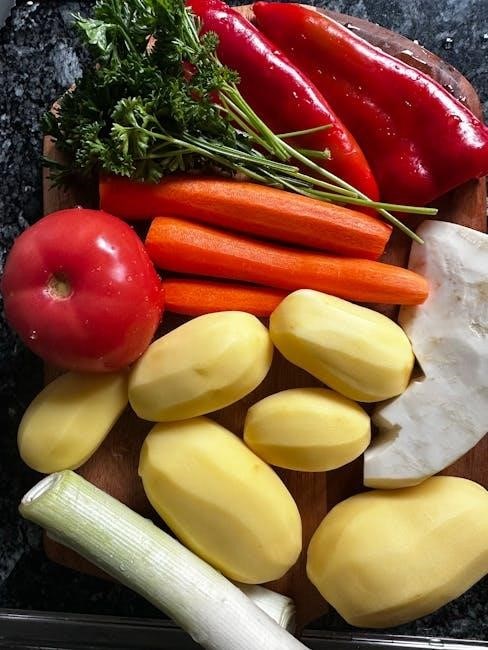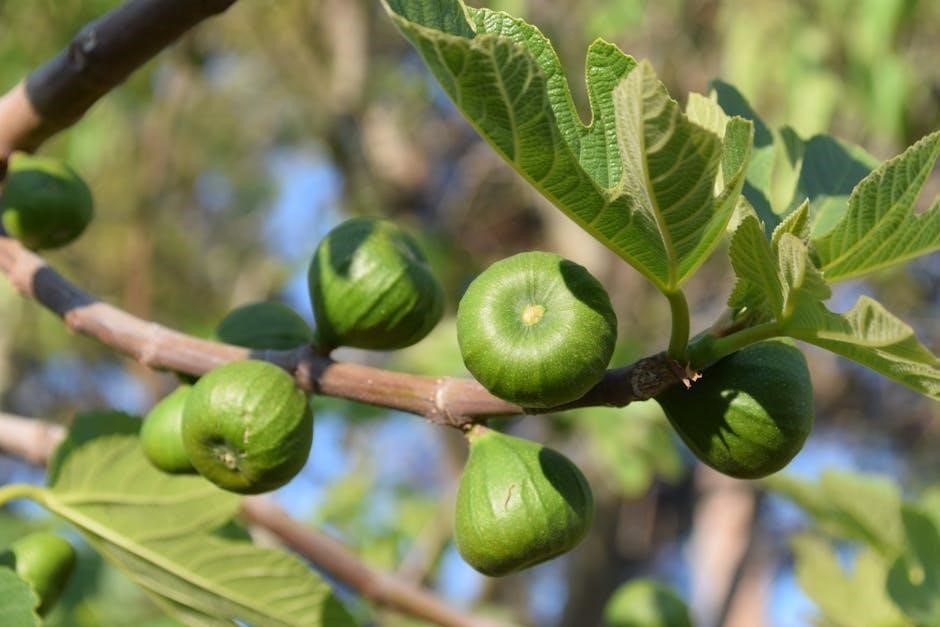Understanding organic reaction mechanisms is key to mastering organic chemistry․ These mechanisms provide detailed insights into the pathways through which chemical transformations occur․ They are fundamental for predicting reaction outcomes and designing efficient synthesis routes, making them essential for students and researchers alike․
1․1 Importance of Understanding Reaction Mechanisms
Understanding reaction mechanisms is fundamental to mastering organic chemistry․ It provides insight into how reactants transform into products, enabling chemists to predict and control reaction outcomes․ By unraveling the steps involved, chemists can optimize reaction conditions, improving efficiency and selectivity․ This knowledge is crucial for synthesizing complex molecules, as it allows the design of targeted pathways and the avoidance of unwanted side reactions․ Moreover, understanding mechanisms facilitates the development of new reactions and catalysts, driving innovation in the field․ It also aids in troubleshooting experimental challenges, making it an indispensable tool for both academic research and industrial applications․
1․2 Overview of Organic Reaction Mechanisms
Organic reaction mechanisms describe the step-by-step processes by which reactants are converted into products․ These mechanisms are classified into substitution, addition, elimination, and rearrangement reactions․ Each mechanism involves specific steps, such as the formation of intermediates like carbocations or carbanions, and transition states that determine the reaction pathway․ Understanding these mechanisms requires knowledge of electron movement, nucleophilicity, and electrophilicity․ The study of reaction mechanisms provides a foundational understanding of how chemical transformations occur, guiding the design of synthetic routes and the optimization of reaction conditions․ This knowledge is essential for predicting reaction outcomes and developing new chemical processes in organic chemistry․
Types of Reaction Mechanisms
Organic reaction mechanisms are categorized into substitution, addition, elimination, and rearrangement reactions․ Each type involves distinct steps and intermediates, shaping the reaction pathway and products․
2․1 Substitution Reactions
Substitution reactions involve the replacement of a leaving group in a molecule with another atom or group․ These reactions are fundamental in organic chemistry, often proceeding via nucleophilic or electrophilic pathways․ In nucleophilic substitution, a nucleophile attacks the electrophilic center, displacing the leaving group․ The mechanism can be unimolecular (SN1) or bimolecular (SN2), differing in the role of the nucleophile and the formation of intermediates like carbocations․ Electrophilic substitution, common in aromatic chemistry, involves the replacement of a functional group by an electrophile․ Solvent, temperature, and steric factors significantly influence the reaction pathway and efficiency․ Understanding substitution mechanisms is crucial for predicting reaction outcomes and designing synthetic routes․
2․2 Addition Reactions
Addition reactions involve the combination of two or more molecules to form a single product, typically by breaking a double or triple bond․ These reactions are common in organic chemistry, particularly with alkenes, alkynes, and carbonyl compounds․ Electrophilic addition is prevalent in alkenes, where reagents like acids or halogens add across the double bond․ Nucleophilic addition occurs with carbonyl compounds, such as aldehydes and ketones, where nucleophiles attack the carbonyl carbon․ Addition reactions can proceed via concerted or stepwise mechanisms, forming intermediates like carbocations or zwitterions․ The regiochemistry and stereochemistry of the products are influenced by the reagent and reaction conditions, making these reactions versatile in organic synthesis․
2․3 Elimination Reactions
Elimination reactions involve the removal of atoms or groups from a molecule, leading to the formation of a double or triple bond․ These reactions typically occur in two main mechanisms: E1 and E2․ In E1, a carbocation intermediate is formed, followed by deprotonation to yield the final product․ E2 involves a single concerted step where a base abstracts a proton while the leaving group departs․ Factors such as the stability of the carbocation (in E1) and steric hindrance (in E2) influence the mechanism․ Common examples include dehydrohalogenation and dehydration of alcohols․ The stereochemistry of the product is also influenced by the reaction conditions, such as temperature and solvent․
2․4 Rearrangement Reactions
Rearrangement reactions involve the migration of atoms or groups within a molecule, leading to the formation of a new structure․ These reactions often occur through the formation of intermediates, such as carbocations or radicals․ A classic example is the hydride or alkyl shift in carbocation rearrangements, which stabilizes the molecule by forming a more stable carbocation․ Such rearrangements are common in acid-catalyzed reactions and can significantly influence the product distribution․ Understanding these processes is crucial for predicting reaction outcomes, as they often determine the final structure of the molecule․ Rearrangement reactions highlight the dynamic nature of organic molecules and their ability to undergo intramolecular transformations․
Key Concepts in Reaction Mechanisms
Understanding electron movement through arrow pushing and recognizing nucleophiles and electrophiles are central to unraveling reaction mechanisms․ These concepts guide the prediction of reaction pathways and outcomes․
3․1 Electron Movement and Arrow Pushing
Electron movement is fundamental to understanding organic reaction mechanisms․ Arrow pushing illustrates how electrons redistribute during bond formation and breaking․ Curved arrows represent the flow of electron pairs, while straight arrows show the movement of single electrons in radical reactions․ Proper arrow pushing helps visualize transition states and intermediates, such as carbocations or carbanions․ It is essential for predicting reaction pathways, including concerted vs․ stepwise mechanisms․ For example, in SN2 reactions, a backside attack is depicted by a single curved arrow․ Mastering this tool enhances the ability to analyze and predict reaction outcomes accurately․
3․2 Nucleophiles and Electrophiles
Nucleophiles and electrophiles are central to organic reaction mechanisms․ Nucleophiles, rich in electrons, attack electrophilic centers, while electrophiles, electron-deficient, attract nucleophilic species․ Common nucleophiles include hydroxide ions, amines, and enolates, while electrophiles like carbonyl carbons and alkyl halides are prevalent․ Their interaction drives reactions such as substitution and addition, shaping reaction pathways․ The strength of nucleophiles and electrophiles influences reactivity and mechanism․ For instance, strong nucleophiles favor SN2 mechanisms, while weak ones may lead to SN1․ Understanding these interactions is vital for predicting and controlling organic transformations․
Reaction Pathways and Intermediates
Reaction pathways outline the sequence of steps in a mechanism, including intermediates․ These temporary species form during reactions and are crucial for understanding how reactants transform into products․
4․1 Transition States and Activation Energy
Transition states are temporary molecular configurations that occur as reactants transform into products․ They represent the highest energy point in a reaction pathway․ Activation energy is the minimum energy required for reactants to reach this state․ It determines the reaction’s rate and is influenced by bond breaking and forming․ Catalysts lower activation energy by providing alternative pathways, speeding up the reaction․ Understanding transition states and activation energy is vital for predicting reaction outcomes and optimizing conditions․ These concepts are central to explaining why certain reactions occur rapidly while others are slow, linking kinetics to reaction mechanisms․
4․2 Carbocations, Carbanions, and Free Radicals

Carbocations are positively charged intermediates with a trivalent carbon, often forming during substitution or elimination reactions․ Their stability increases with substitution due to hyperconjugation and inductive effects․ Carbanions are negatively charged species, typically generated in basic conditions, playing roles in nucleophilic reactions․ Free radicals are highly reactive molecules with unpaired electrons, involved in chain reactions like polymerization․ These intermediates are crucial in understanding reaction pathways, influencing reactivity, and determining the course of organic transformations․ Their stability and reactivity are key factors in predicting reaction outcomes and mechanistic routes․

Role of Oxidation Levels in Reactions
Oxidation levels determine electron loss or gain, influencing reaction feasibility, intermediate stability, and overall pathways in organic mechanisms and reaction control․
5․1 Identifying Oxidation States
Oxidation states are critical in understanding organic reaction mechanisms, as they indicate the loss or gain of electrons by atoms․ They are assigned based on rules, such as hydrogen being +1 and oxygen -2․ Identifying oxidation states helps determine if a reaction involves oxidation (increase in oxidation state) or reduction (decrease)․ This is vital for balancing redox reactions and understanding mechanistic pathways․ For example, in oxidation of alcohols to ketones, the oxidation state of carbon increases․ Accurate identification of oxidation states is essential for predicting reaction outcomes and identifying intermediates, making it a foundational tool in mechanistic analysis and experimental design․
5․2 Oxidation and Reduction Processes
Oxidation and reduction processes are fundamental in organic reaction mechanisms, involving the transfer of electrons․ Oxidation occurs when a molecule loses electrons, often resulting in the formation of bonds to oxygen or the loss of hydrogen․ Reduction is the opposite, where a molecule gains electrons, typically involving the addition of hydrogen or the loss of oxygen․ These processes are driven by the presence of oxidizing or reducing agents, such as KMnO4 or NaBH4․ Understanding these transformations is crucial for predicting reaction pathways and synthesizing target molecules․ Oxidation and reduction often dictate the reactivity and selectivity of intermediates, making them central to mechanistic studies and organic synthesis strategies․

Stereochemistry in Reaction Mechanisms
Stereochemistry plays a critical role in reaction mechanisms, determining the spatial arrangement of atoms and influencing bond formation and cleavage․ It shapes the outcomes of organic transformations․
6․1 Stereochemical Outcomes
Stereochemical outcomes in organic reactions are determined by the spatial arrangement of atoms during bond formation and cleavage․ These outcomes are critical in understanding reaction mechanisms, as they dictate the formation of stereoisomers․ Stereoisomers, such as enantiomers and diastereomers, arise from differences in the three-dimensional arrangement of substituents․ Reaction mechanisms often favor specific stereochemical pathways due to factors like steric hindrance, orbital orientation, and transition state geometry․ For instance, SN2 reactions proceed with inversion of configuration, while E2 mechanisms favor anti-periplanar geometries․ Understanding stereochemical outcomes is essential for predicting product distributions and designing syntheses of specific stereoisomers․
6․2 Factors Influencing Stereochemistry
Several factors influence the stereochemical outcomes of organic reactions, including steric effects, electronic effects, and reaction conditions․ Steric hindrance can direct approaching groups to specific sides of a molecule, affecting the spatial arrangement of substituents․ Electronic factors, such as the presence of electron-donating or withdrawing groups, can stabilize certain transition states, leading to preferred stereochemical pathways․ Solvent polarity and temperature also play roles, as they can alter reaction kinetics and stabilize intermediates․ Additionally, the presence of catalysts or enzymes can impose stereochemical control by lowering activation energy for specific pathways․ Understanding these factors is crucial for predicting and controlling stereochemical outcomes in organic reactions․

Electronic Factors in Reaction Mechanisms
Electronic factors, such as resonance, induction, and hyperconjugation, significantly influence reaction mechanisms by stabilizing transition states and intermediates, guiding the flow of electrons and reaction pathways․
7․1 Resonance and Delocalization
Resonance and delocalization are crucial electronic factors that influence organic reaction mechanisms․ Resonance involves the redistribution of electrons within molecules, leading to multiple equivalent Lewis structures․ These structures help predict reactivity by identifying regions of electron-rich or electron-deficient areas․ Delocalization, a related concept, refers to the spreading of electrons across multiple atoms or molecular orbitals, stabilizing molecules like benzene․ This stabilization lowers the activation energy for reactions and directs the pathway of electron movement․ Understanding resonance and delocalization is essential for predicting how molecules behave in reactions, as these factors often determine the most favorable transition states and intermediates․
7․2 Inductive and Hyperconjugative Effects
Inductive and hyperconjugative effects are significant electronic factors influencing organic reaction mechanisms․ The inductive effect involves the electron-withdrawing or electron-donating properties of substituents through sigma bonds, altering the reactivity of molecules․ For instance, alkyl groups donate electrons inductively, while halogens withdraw them․ Hyperconjugation, on the other hand, stabilizes molecules by delocalizing electrons from sigma bonds into adjacent pi systems or vacant orbitals․ This effect is crucial in stabilizing carbocations and alkenes․ Both effects play a key role in determining reaction pathways, as they influence the stability of intermediates and transition states․ Understanding these phenomena is vital for predicting and controlling reaction outcomes in organic chemistry․

Common Reaction Mechanisms
Common reaction mechanisms include substitution, addition, elimination, and rearrangement processes․ These pathways describe how reactants transform into products, guiding the design of synthetic strategies in organic chemistry․
8․1 SN1 and SN2 Mechanisms
SN1 and SN2 mechanisms are fundamental substitution pathways in organic chemistry․ The SN1 mechanism proceeds via a two-step process: formation of a carbocation intermediate and subsequent nucleophilic attack․ This pathway is favored in polar protic solvents and with tertiary substrates due to greater carbocation stability․ In contrast, the SN2 mechanism involves a single concerted step with a backside nucleophilic attack, resulting in inversion of configuration․ It thrives in polar aprotic solvents and with primary substrates․ Both mechanisms are influenced by solvent, substrate structure, and nucleophile strength, making them critical in understanding nucleophilic substitution reactions and their stereochemical outcomes․
8․2 E1 and E2 Mechanisms
E1 and E2 mechanisms are elimination pathways in organic chemistry․ The E1 mechanism involves a two-step process: formation of a carbocation intermediate followed by deprotonation to form a double bond․ It typically occurs in polar protic solvents and is favored by tertiary substrates due to stable carbocations․ In contrast, the E2 mechanism is a single-step, concerted process where a strong base abstracts a proton anti to the leaving group, resulting in simultaneous bond cleavage and double bond formation․ E2 is favored in polar aprotic solvents and with strong bases․ Both mechanisms are influenced by solvent, substrate, and base strength, playing a key role in elimination reactions․
8․3 Electrophilic Addition and Elimination
Electrophilic addition and elimination are fundamental processes in organic chemistry, particularly for unsaturated compounds like alkenes, alkynes, and aromatic systems․ Addition involves the incorporation of an electrophile into π-bonds, forming new sigma bonds․ This is often seen in reactions like acid-catalyzed hydration of alkenes or bromine addition․ Elimination, conversely, removes atoms or groups to restore unsaturation, such as in dehydrohalogenation․ These mechanisms are influenced by solvent, temperature, and the nature of the electrophile․ Concerted vs․ stepwise pathways dictate stereochemical outcomes, with intermediates like carbocations forming in some cases․ Understanding these processes is crucial for predicting reaction pathways and controlling product formation in organic synthesis․

8․4 Nucleophilic Acyl Substitution
Nucleophilic acyl substitution involves the replacement of a leaving group in a carbonyl compound by a nucleophile․ This mechanism is central to reactions like ester hydrolysis, amidation, and acylation․ The nucleophile attacks the electrophilic carbonyl carbon, forming a tetrahedral intermediate, which then eliminates the leaving group․ The reaction can proceed via a concerted or stepwise pathway, depending on the substrate and conditions․ Steric and electronic factors, such as the steric hindrance around the carbonyl group and the quality of the leaving group, significantly influence the reaction rate․ This mechanism is fundamental in organic synthesis and biochemistry, enabling the formation of diverse carbonyl compounds․
Kinetics and Thermodynamics in Reactions
Kinetics studies reaction rates and mechanisms, while thermodynamics examines the stability and energy changes․ Together, they explain how reactions proceed and which products are favored․
9․1 Rate-Determining Steps
The rate-determining step (RDS) is the slowest step in a reaction mechanism, controlling the overall reaction rate; It determines the activation energy and is critical for understanding reaction kinetics․ Identifying the RDS helps clarify the mechanism and optimize reaction conditions․ The RDS is influenced by factors like temperature, catalysts, and concentrations, which alter its rate․ Catalysts lower the activation energy of the RDS, accelerating the reaction․ Experimental rate laws are derived from the RDS, connecting reactant concentrations to reaction rates․ Understanding the RDS is essential for predicting and controlling reaction outcomes in organic chemistry․
9․2 Thermodynamic vs․ Kinetic Control
Thermodynamic control and kinetic control are fundamental concepts in reaction mechanisms․ Thermodynamic control determines the most stable product based on Gibbs free energy, often favoring the more stable product over time․ Kinetic control, however, dictates the product formed fastest, influenced by the activation energy of the rate-determining step․ Reaction conditions, such as temperature and solvent, can shift control between these factors․ Understanding the interplay between thermodynamics and kinetics is crucial for predicting product distributions and optimizing synthetic pathways․ This balance is key in organic chemistry, allowing chemists to design reactions that favor desired outcomes․
Experimental Methods for Mechanism Determination
Experimental methods for mechanism determination involve techniques like spectroscopy and kinetic studies․ Isotope effects and trapping agents help identify intermediates and pathways․
10․1 Use of Intermediates and Trapping Agents
The identification of intermediates is crucial for elucidating reaction mechanisms․ Trapping agents, such as thiols or alcohols, are used to stabilize and capture reactive intermediates like carbocations or radicals․ By analyzing the trapped species, researchers can infer the reaction pathway and confirm the presence of specific intermediates․ This method is particularly effective in distinguishing between concerted and stepwise mechanisms․ For example, in SN1 reactions, carbocations can be trapped, supporting the two-step mechanism․ Similarly, in radical reactions, spin traps help detect and identify radical intermediates․ These experimental approaches provide direct evidence of the intermediates, aiding in the validation of proposed mechanisms and refining theoretical models․
10․2 Kinetic Isotope Effects and Stereochemical Studies
Kinetic isotope effects (KIE) are powerful tools for probing reaction mechanisms․ By substituting isotopes (e․g․, deuterium for hydrogen), researchers can determine if bond breaking is occurring in the rate-determining step․ A large KIE indicates significant bond cleavage, while a small KIE suggests otherwise․ Stereochemical studies, on the other hand, examine how spatial arrangements influence reactivity and product formation․ Techniques like racemization or stereochemical retention can reveal whether intermediates form or if reactions proceed via concerted pathways․ These methods, combined with isotopic labeling, provide critical insights into transition states and reaction pathways, helping to distinguish between competing mechanisms and refine theoretical models․

Computational Methods in Mechanistic Studies
Computational methods, such as molecular orbital theory and modeling, provide detailed insights into reaction mechanisms, helping to predict transition states and elucidate reaction pathways efficiently․

11․1 Molecular Orbital Theory
Molecular orbital (MO) theory is a computational approach that describes the distribution of electrons in molecules․ It combines atomic orbitals to form molecular orbitals, providing insights into electronic structure and bonding․ MO theory helps predict the reactivity of molecules by analyzing the energy levels of these orbitals․ In organic chemistry, it is used to study how electrons redistribute during reactions, influencing reaction pathways․ Key concepts include HOMO (highest occupied molecular orbital) and LUMO (lowest unoccupied molecular orbital), which play roles in nucleophilic and electrophilic interactions․ MO theory is a powerful tool for understanding reaction mechanisms, enabling chemists to design new reactions and materials effectively․

11․2 Computational Modeling of Transition States
Computational modeling of transition states is a powerful method for studying reaction mechanisms․ Transition states are the highest energy points on a reaction pathway, and their structures are critical for determining reaction outcomes․ Using computational techniques like density functional theory (DFT), chemists can model transition states to understand their geometries and energies․ These models help predict reaction pathways and identify potential intermediates․ Computational methods also enable the calculation of activation energies, providing insights into reaction kinetics․ By mapping potential energy surfaces, researchers can design new reactions or optimize existing ones․ This approach bridges theory and experiment, advancing the understanding of organic reaction mechanisms and their applications․
Understanding reaction mechanisms is crucial for predicting outcomes, optimizing processes, and driving innovation in organic chemistry, enabling the development of efficient synthetic methods and molecular design advancements․
12․1 Summary of Key Concepts
In organic chemistry, understanding reaction mechanisms involves recognizing nucleophiles, electrophiles, and intermediates like carbocations and free radicals․ Transition states and activation energy govern reaction pathways, while stereochemistry influences product formation․ Oxidation levels and electronic effects, such as resonance and induction, guide reactivity․ Key mechanisms include SN1/SN2, E1/E2, and nucleophilic acyl substitution․ Kinetics and thermodynamics differentiate between rate-determining steps and equilibrium outcomes․ Experimental methods like isotope effects and computational tools aid mechanism determination․ These concepts collectively explain how reactions proceed, enabling chemists to design efficient synthetic routes and predict outcomes effectively․
12․2 Importance of Mechanisms in Organic Chemistry
Understanding reaction mechanisms is fundamental to organic chemistry as it provides insight into how molecules transform during reactions․ Mechanisms explain the sequence of steps, intermediates, and transition states, enabling chemists to predict reactivity and select appropriate conditions․ This knowledge is crucial for designing efficient synthetic pathways, optimizing reaction yields, and developing new materials or drugs․ By identifying rate-determining steps and key intermediates, mechanisms also guide the improvement of existing processes, reducing costs and environmental impact․ Ultimately, mastering mechanisms allows chemists to control and manipulate molecular behavior, advancing both academic research and industrial applications․

